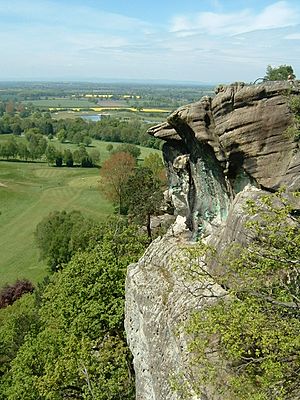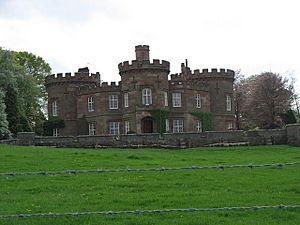Hawkstone Park facts for kids
Quick facts for kids Hawkstone Park |
|
|---|---|

Part of Hawkstone Park
|
|
| Type | Historic landscape |
| Location | Weston-under-Redcastle, Shropshire, England |
| Nearest town | Wem |
| Area | 100 acres (40.47 ha) |
| Operated by | Hawkstone Hall |
| Status | Open |
Hawkstone Park is an amazing historic park in Shropshire, England. It's a special place with beautiful gardens, fun buildings called follies, and cool rocky areas. People used to visit it as part of a big trip called the English Grand Tour.
You can find Hawkstone Park near the village of Weston-under-Redcastle, not far from Wem. It's famous for its unique follies, which are like decorative buildings or ruins built just for fun!
Contents
Exploring Hawkstone Park
Today, Hawkstone Park covers about 100 acres (40 hectares) of land. It's filled with interesting follies, beautiful landscaped gardens, and natural rock formations. All of this is built around the old ruins of a medieval castle called Red Castle.
The park became really special thanks to people like Richard Hill in the early 1700s. Later, his nephew, Sir Rowland Hill, and then Sir Richard Hill, 2nd Baronet, added even more amazing features during the 18th century. They made the park famous!
After a long time of being forgotten, the park started to be restored in 1990. It reopened in 1993 and is now a Grade-1 listed site on the National Register of Historic Parks and Gardens.
To see everything, you'll need to go on a 2.5-hour hike. It has many steps, hills, and slopes, so you'll need to be quite fit! Sometimes, not all paths are open, so it's good to check before you visit.
What to See at the Park
There are many exciting things to discover at Hawkstone Park:
- The White Tower: This tower was once painted white and is made of red brick.
- The Monument: This tall structure, over 100 feet (30 meters) high, remembers Sir Rowland Hill of Soulton. He helped with the Geneva Bible translation and was a Protestant Mayor of London.
- The Cleft and Swiss Bridge: A deep crack in the rock that you can cross on a bridge.
- The Grotto: This cave might have been an old copper mine from the 5th century!
- The Arch: Found at the top of Grotto Hill.
- Many other caves, tunnels through the rock, walking paths, amazing viewpoints, and trails winding through beautiful Rhododendron plants.
History of Hawkstone Park
The Red Castle
The first castle at Hawkstone Park was called Red Castle. It was built in 1227 by Henry de Audley. He was the Sheriff of Shropshire and Staffordshire. This castle was made of sandstone on a natural rock outcrop, surrounded by wide valleys.
The castle had many names over time, like Rubree, Radeclif, and Castle Rous. The Audley family owned it for a long time. However, by the 1400s, it seems the castle was no longer used. When a historian named Leland visited around 1540, he said it was already in ruins. The Red Castle site is now closed to the public because it's not safe.
The Hill Family and the Park's Development
The land around Hawkstone Park eventually came into the hands of the Hill family. Richard Hill (1655–1727), also known as 'The Great Hill', built the main house, Hawkstone Hall, around 1707. He was a traveler and diplomat who made a lot of money.
His nephew, Sir Rowland Hill, 1st Baronet (1705–1783), really started to shape the park. He added many of the follies and created walking paths. He even had a garden hermit who would give wise advice to visitors!
Sir Richard Hill, 2nd Baronet (1733–1808) continued his father's work. He wrote a guide for visitors and built the 'Hawkstone Inn' for them to stay. He hired a landscape gardener named William Emes to create a huge man-made lake called the Hawk River. His follies included a 'ruined' Gothic architecture Arch, a tribute to an ancestor, the Swiss Bridge, and a 100-foot (30-meter) obelisk with a statue of the original Sir Rowland Hill on top. By the time he died in 1808, Hawkstone Park was one of Britain's most popular attractions.
Later, Sir Rowland Hill, 4th Baronet (1800–1875) inherited the park. He spent a lot of money and built new drives, including one through a rock cutting. He also built a special house called The Citadel in 1824-25. However, his spending caused financial problems for the family.
By 1895, the family faced bankruptcy, and parts of the estate had to be sold off.
During World War II, some parts of the park were used as a prisoner of war camp.
Today, Hawkstone Park has been mostly restored and is open for everyone to enjoy. It is protected as a Grade I historic park by English Heritage.
Current Activities at Hawkstone
Hawkstone Park is now connected to a hotel (which used to be a lodge for the hall) and a golf course.
Golf Course
Hawkstone Park has two 18-hole golf courses that are set within the beautiful parkland. Famous golfer Sandy Lyle learned to play golf here from his father, who was the golf professional at Hawkstone.
See also
- Listed buildings in Weston-under-Redcastle


